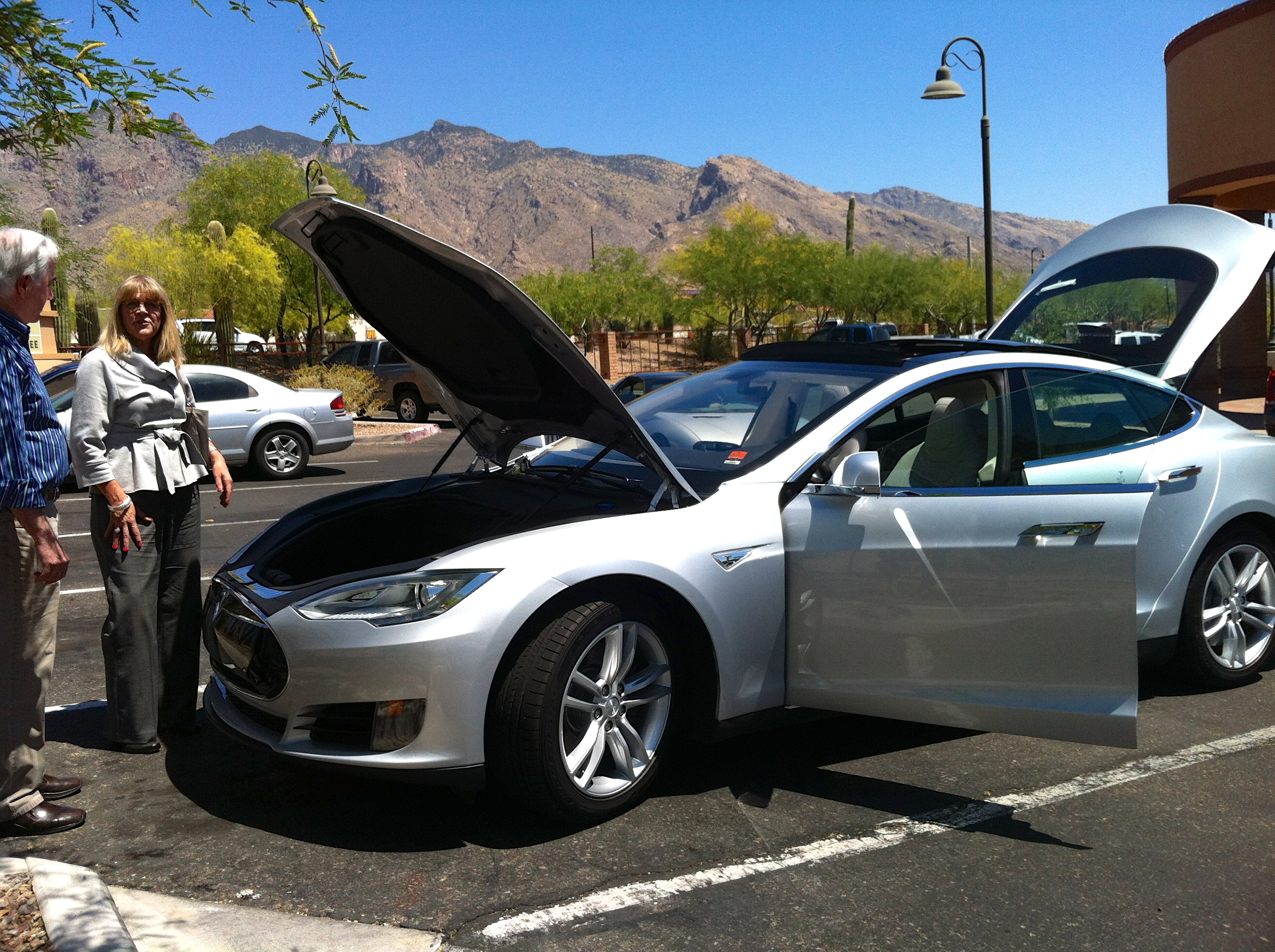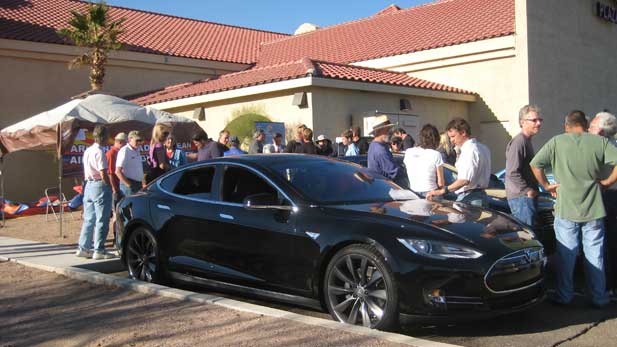April 22 was Earth Day. For some, this conjures fears of global warming, oil shortages and rising gas prices, threats that signal the impeding and almost certain death to gasoline-powered vehicles.
Automotive enthusiasts and consumers alike are shifting their priorities when shopping for cars, as demonstrated by the growing popularity of efficient and smaller models, alternative fuel and electric vehicles.
However, EV’s are not an easy sell. They carry a stigma of being slow with short ranges and limited practicality. To many, the idea of driving an EV has only ever been mildly appealing.
Coupled with arguments that EV’s take too long to charge, it is unlikely that the U.S. will reach the DOE’s goal of 1 million electric cars on the road by 2015.
There is hope for Arizonans, though.

Kari Schlachtenhaufen shows her new Model S to a curious bystander
As one of the original cities to benefit from the federally funded EV Project, which installs electric-car chargers across America, Tucson is becoming a leader in EV charging infrastructure as nearly 250 charging stations will be installed in the Tucson metropolitan area through the EV Project.
The latest report from the U.S. Department of Energy states 192 charging units in the Tucson Metropolitan Area have been installed by the EV Project as of December 2012.
Now, Tucson is one of 21 cities in nine states participating in the EV project, funded with a $114.8 million DOE grant.
A local initiative, Tucson Clean Cities, is a voluntary program of the Pima Association of Governments and the DOE that among other tasks, is promoting and developing the use of electric vehicles and charging infrastructure across the Tucson Metropolitan area.
Range Anxiety

A Tesla Model S juicing up at a Picacho Shell Station fast-charging unit Photo: Benjamin Nead/Arizona Public Media
In December 2012, Tucson Clean Cities opened an electric-vehicle fast-charging station at the Picacho Shell Station (Exit 219 East Camino Adelante Road.)
“Adding electric vehicle fast-charge stations is key in moving Arizona’s EV infrastructure forward,” said Colleen Crowinshield, manager of the Tucson Clean Cities Program at Pima Association of Governments.
“It will help reduce any range anxiety felt for EV motorists traveling between Tucson and Phoenix areas,” said Crowinshield.
Fast-charge stations can take as little as 15 – 45 minutes to fully charge a electric vehicle, whereas conventional 120-volt or 220-volt outlets can take an EV between eight and 12 hours to reach full charge.
Two models have dominated the EV market; the Chevrolet Volt (introduced 2011) and Nissan Leaf, which launched in Tucson as one of the cities supported by the EV Project.
However, as Tucson continues to evolve as a leader among cities for EV ownership, the newest and perhaps most significant car – EV or not – is infiltrating the Tucson and state-wide markets.
Tesla
“It may very well be the most important new car since the Model T.”
– Carlos Lago, Associate Road Test Editor, Motor Trend Magazine

Buttery soft Nappa leather and Obeche matte finish wood trim evoke contemporary luxury

A 17″ iPad-like screen contains the majority of controls an dominates the center stack
Tesla is emerging as the first sustainable answer to wide-spread EV motoring. Both Toyota and Daimler AG have invested in the start-up, sustaining steady sales of it’s Model S sedan and positive cash flow allowing Tesla to re-pay its conditional loans released under DOE’s Advanced Technology Vehicles Manufacturing (ATVM) Loan Program,
Early adopters of Tesla such as Kari Schlachtenhaufen, Director of Development at the University of Arizona Department of Surgery, enjoy a plug-in electric vehicle tax credit of $7,500 and are taking advantage of the forward-thinking EV movement in Southern Arizona.
Schlachtenhaufen took delivery of her 2013 Tesla Model S in just three days ago.
“The car weighs 4,600 pounds and the acceleration zero-60 is under four seconds” said Schlachtenhaufen.
The heavy battery-packs are located low and in the center of the car to provide good weight distribution and a low center of gravity for greater handling.
“It’s very, very quiet.” So far Schlachtenhaufen loves “the speed, the power and driving by gas stations.” She had a Tesla specific ‘Supercharger’ installed in her home to enable her to charge anytime.
Tesla is developing a network of ‘Superchargers’ that take as little as one hour to fully charge a Tesla, or provide about 150 miles in range after just 30 minutes. Tesla hopes to eventually cover the U.S. with Superchargers (which, so far, only charge Tesla EV’s) and expects to have 100 stations by 2015.
“It’s very green, it’s beautiful and it’s my last car I’m ever going to buy,” said Schlachtenhaufen.
So what pushed Kari to become an early adapter? “The first New York Times review, not the second.” – The ‘second‘ referring to the infamous scathing review by the Times early this year, which was met with much resistance by Tesla CEO Elon Musk.
According to Chris Swann, a Tesla delivery specialist out of Phoenix, Tucson initially took more deliveries of the Model S than Phoenix.

Trick pop-out door handles are a unique and impressive touch to the Model S

Not obviously recognizable the sleek exterior design conceals a hatchback that allows easy access to the spacious cargo area
Taking delivery of a Tesla in Arizona is not easy. Tesla operates its Scottsdale locations as a store – not dealership – as Arizona is one of four states with restrictive laws that don’t allow Tesla to sell directly to customers.
As a result, unlike other deliveries, there can be no Tesla Delivery Specialist that can accompany the vehicle here, “it is simply put on a carrier with a driver and dropped off at your place,” said Schlachtenhaufen.
The Tesla notes that “The Gallery does not sell cars, but serves as a place to educate visitors about our groundbreaking electric vehicles.”
Another part of the fine print: state law does not permit test drives except through “authorized dealers” which Tesla has not created.
A Tesla service center is set to open in Scottsdale soon, and will be Tesla’s first service center in the state. This will alleviate the need for current Arizona Tesla owners to ship their cars off for service out of state.
Schlachtenhaufen’s biggest complaint so far? “There’s no light!” she said as she flips open the vanity mirror on the reverse of the sun-visor.
“I love cars, I lived in Detroit for a long time and you pick up the bug, and so this is just fun.” She already joined the passionate Tesla Motors Club online forum. “I asked if anybody wanted to stat a Tesla club in Tucson – and I haven’t heard back”
She’s keeping her previous car – a Chevrolet Suburban – because she “loves it”.

